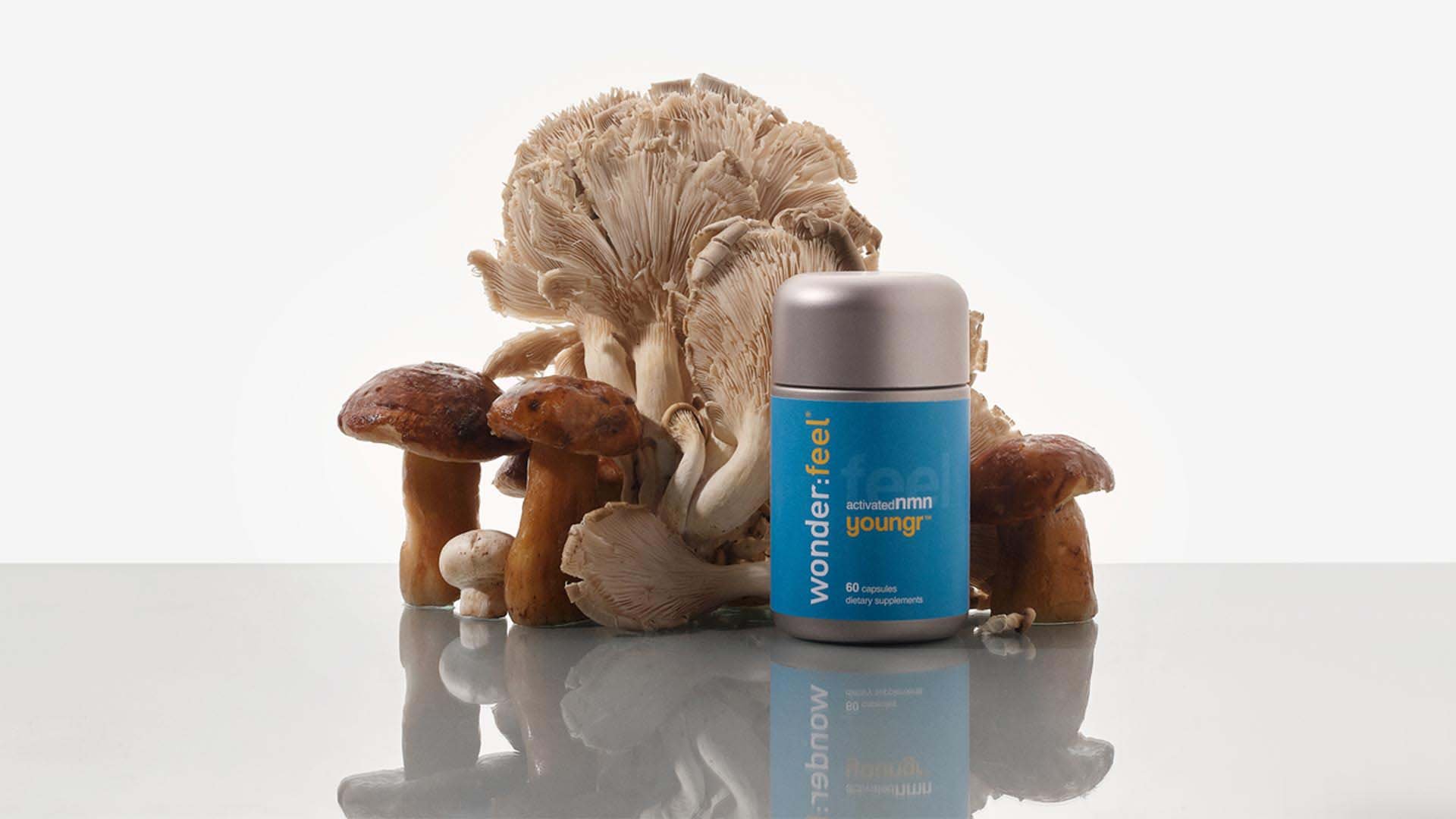When you start talking about healthy foods, mushrooms tend to make the list. In addition to an impressive mix of vitamins and minerals, mushrooms are also full of a specific antioxidant known as ergothioneine, (AKA ergo), which has been dubbed the “longevity vitamin.” Sounds promising, right? Mushrooms, notably porcinis and lion’s mane, are the leading source of ergo, though it is found in small amounts in many other foods. Here’s why supplementing with daily ergothioneine may have impressive benefits and the best way to get that daily ergo dose. Spoiler—if you aren’t a mushroom fan, we have a handy workaround.
A brief introduction to ergothioneine, the adaptive antioxidant
Ergo was discovered in 1909. As an antioxidant, it can help offset oxidative damage directly linked to chronic disease – pretty standard for this class of compounds. But fast forward a century and change, and excitement is growing over ergo’s ability to not only reduce oxidative stress, but also serve “as an anti-inflammatory agent with the potential to serve as a therapeutic agent.” Intriguing, right?

The evidence is building regarding that therapeutic impact, which makes the benefits of ergothioneine wonderfully unique among antioxidants. High levels of ergo have been observed in certain cells predisposed to oxidative stress, but with sustained administration, other tissues can also accumulate high amounts. In fact, animal disease models showcase what appears to be an adaptive physiological response to elevated ergo in damaged tissue, which actually limits further injury. In other words, ergo accumulates where it’s really needed, in cells that are dealing with excessively high oxidative stress– think fatty liver disease, liver fibrosis, hearts ridden with high blood pressure, and instances of pre-eclampsia – which appears to be a deliberate cytoprotective action, well, in action.
All mammals have an ergothioneine transporter
We know this all sounds fantastic, but how exactly does ergo do it all? It’s actually pretty cool. Ergo essentially behaves like a vitamin—we can’t produce it ourselves, but boy, do we need it. In the dizzyingly complex system that is the human body is a highly specific cell membrane transport protein known as the SLC22A4 gene, AKA OCT-N1. In 2005, it was identified in all mammals, and the very fact that we have it is a pretty significant indication that ergo is a really important component for our bodies. Food-derived ergo zips through this transporter for speedy, highly efficient delivery from the intestine to various points in the body, including bone marrow, the small intestine, kidneys, trachea, lungs, cerebellum, monocytes, and the eyes. Once it’s made it to our cells, ergo triggers a range of biological actions that support and promote cellular function, from those antioxidant benefits we’ve already covered to inflammation regulation and detoxification.
Health benefits of ergothioneine: Beyond the basics
As an antioxidant, ergo neutralizes free radicals, those unstable molecules that contribute to aging and disease in the body, to combat oxidative stress. It’s a process that protects cells against damage and reduces the risk of all sorts of chronic diseases in risk-prone areas, like the liver, kidneys, brain, and the eyes. As an organ, the eye navigates extensive oxidative stress, which means it needs antioxidants to mount a regular defense. Would you be surprised to learn that high levels of ergo are found in various parts of the eye and levels are noticeably lacking in people with serious cataract issues? Didn’t think so!
Ever heard of inflammaging? It’s the low-grade inflammation that goes hand in hand with aging and increases the likelihood of developing diseases like cancer, dementia, chronic kidney disease, and more. Good news—ergo has impressive anti-inflammatory properties that may help fend off inflammaging.
There’s also an interesting mother-baby axis, with ergo present in human breast milk and the urine and brains of newborns. The logical conclusion is that ergo can either cross the placenta or be absorbed through breast milk – or both.
Interestingly, there is evidence that during the nursing process, transporter cells in breast tissue are six times more active than in non-lactating breasts, suggesting this is a key delivery process of ergo to an infant. And if you follow that train of thought, it makes sense that the benefits of ergothioneine are just as important to babies as it is to the rest of us. Still, more research is needed before we can say so definitively.

Studies are also drawing a link between ergo and heart health. The powerhouse antioxidant may improve the function of blood vessels, reducing the risk of cardiovascular diseases. But the biggest benefit of ergo may be how it supports the brain.
The brain benefits of ergothioneine
Studies are beginning to clarify the role ergo plays in brain health, especially as we age. Memory loss and cognitive decline are hallmarks of aging, and oxidative stress can be an accelerant of these symptoms. Antioxidants, like ergo, neutralize free radicals and that’s particularly beneficial in the brain—because it uses so much oxygen, it’s especially susceptible to oxidative damage.
Garden-variety stress is hard on the brain as well and ergo has been described as a “stress vitamin” with stress-busting benefits. In the brain specifically, ergo may help shield against the harmful effects of cortisol, mitigate inflammation, and protect cells from damage associated with chronic stress, which can help support cognitive function.
Getting older also increases the risk of neurodegenerative diseases, including Alzheimer’s and Parkinson’s disease. At this point, you may not be surprised to learn that low levels of ergo have been found in people with cognitive difficulties compared to people of the same age without any sort of cognitive impairment. Ergo levels in the blood have also been shown to be lower in people with Parkinson’s disease while a new study investigating the efficacy of ergo as a means of delaying cognitive decline found improved performance in memory and learning abilities and a reduction in neuronal damage. Plus, it validated the safety of supplemental ergo intake. The takeaway is that low blood ergo levels could be a precursor to some of the neurological diseases experienced as we age and it may even be linked to the general decline in brain function we experience the older we become.
Ergo’s biologically useful function?
Get this—studies show ergo hits its marks within an hour of eating that mushroom ravioli. What’s more, it’s slow to leave the body, with impressively high retention levels, particularly in comparison to other antioxidants. Instead of hanging around for mere hours, as is the case with antioxidants like PQQ and Quercetin, ergo levels continue to increase in the blood for up to four weeks after being consumed. Our capacity to not only absorb ergo but retain it for such lengthy time periods is a big neon sign suggesting this antioxidant, in particular, serves a distinct purpose in the human body. As Professor Barry Halliwell, who was honored as a 2021 Citation Laureate for his work on antioxidants deemed to be of “Nobel Class,” so reasonably puts it, that ability to retain “implies that ergo has a useful function, otherwise why absorb and retain it?”
Neither humans nor animals can synthesize ergo – we can’t make it ourselves, so we need to access this key micronutrient from our diets. And when we say need, we mean it. Besides the link to those neurodegenerative conditions, there’s the fact that “limited intake of ergo in the diet may compromise long-term health and life expectancy.” A 2024 study on male mice, meanwhile, showed that daily ergo supplementation had a remarkable effect on their lifespan and significantly lower age-related declines in weight, fat mass and movement velocities, along with improvements in age-related impairments in learning and memory ability compared to the control group. Researchers concluded that ergo could very well be “an important vitamin-like compound leading to healthy longevity.”
Fun fact—American diets aren’t delivering ergo in the same amounts as some European diets. This could explain why Americans tend to have more age-related health issues than people in other developed countries. It’s estimated that the average American consumes just 1.1 mg of ergo in a day, compared to 4.6 mg per day for Italians. Mushroom consumption as a whole has a lot of benefits, including reduced instances of other aging-related diseases, including prostate cancer, dementia, and risk factors for diabetes. We can’t point to ergo as the sole reason for that just yet, but growing research is close to drawing that conclusion.
Mushroom varieties richest in ergothioneine
If you’re more than ready to jump on the mushroom train and up your ergo intake, you’re probably wondering which fungi are highest in this powerhouse antioxidant. According to the American Society for Nutrition, king oysters, maitake, oyster, shiitake, and lion’s mane varieties are good choices, with ergo content up to 13 mg per 3-ounce servings. Cordyceps and porcini are also best bets, with a whopping 782 mg and a little over 7 mg, respectively, measured by dry weight. What’s more, cooking mushrooms doesn’t affect ergo content. Ergo is also found in small amounts of black and red beans, oat bran, organ meats and fermented foods like tempeh and soybean curd.
If you’re a self-proclaimed mushroom hater and your panic is growing as you read, good news. You can still get ample daily ergo without ever eating another fungi!
Enter Wonderfeel Youngr™
It’s the latest, greatest iteration of Wonderfeel’s NMN formula, and it is positively packed with ingredients proven to benefit you in countless ways. In addition to NMN, vitamin D3, and resveratrol, we’ve included—you guessed it—ergo! And to dial in on the most effective amount for our supplement, we referenced all of the latest scientific research and papers and consulted leading authorities on ergo, Professor Robert Beelman and the aforementioned Professor Halliwell. They confirmed that our 4 mg ergo dose in Wonderfeel Youngr™ is both safe and highly effective. It’s an excellent addition to the other ingredients in our formula, and a simple way for people to capitalize on the longevity vitamin—even if they hate mushrooms.













